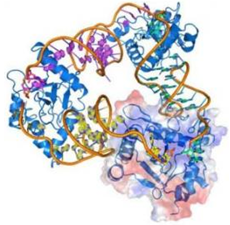The Chromosome Structure of a RNA Antitoxin Complex and Its Altruistic Mechanism

A new research reveals how some bacterial cells keep a 'suicide complex' ready to hand.
In the journal Proceedings of the National Academy of Sciences, you will find an article which talks about some bacterial cells carry a molecular 'suicide complex' to kill themselves in the event of lethal infection by viral parasites. This mechanism finding came from the bacterial plant pathogen Pectobacterium atrosepticum study conducted by Professors George Salmond and Ben Luisi in the University of Cambridge's Department of Biochemistry. And the research was funded by the Biotechnology and Biological Sciences Research Council (BBSRC).
The research found that such 'altruistic suicide' prevents or limits viral replication and protects the rest of the bacterial population from subsequent infection. But how did they do this? In order to find out, they did relevant observation and study finding that through a high-risk strategy in which bacteria kept their lethal weapon at hand all times, but is neutralised until viral infection of the bacterial cell triggers its release from inhibition. The research explores the powerful ToxN-inhibiting activity of the ToxI RNA.
They found a suicide complex, ToxIN, is not induced but exists all the time in the bacterial cell; to avoid killing the bacterial cell, ToxIN is held in a suppressed, inert form until viral infection triggers the release of a protein toxin (ToxN) from an RNA antitoxin (ToxI) partner. The toxin then causes the death of both the bacterium and the infecting virus. The success of the antiviral system therefore depends heavily on maintaining a very strong inhibition or suppression of the toxin by its RNA antitoxin, to ensure that the host cell is not damaged in the absence of invading viruses or other stresses. Small RNAs have multiple essential roles in bacteria, but examples of naturally occurring RNA molecules that act as direct protein inhibitors are rare.
Together all, they knew that the assembly of the inhibited complex is driven entirely by the sequence of the ToxI RNA as well as its interactions with ToxN. The study shows that ToxI RNAs are highly selective inhibitors, each active against only their own specific toxin partner. The targeted chromosome structure, a second ToxI-ToxN complex, encoded by a plasmid of the bacterium Bacillus thuringiensis reveals that this selectivity is a consequence of subtle, complementary structural variations in both RNA and protein, and its precise molecular recognition needed to form an inactive complex cannot occur between mismatched partners.
In addition, the work shows that ToxIN systems promote their own maintenance on plasmids as selfish DNA that probably increases their spread, and retention, in bacterial populations.
Their discovery could guide scientists to start the development of new small molecule antibacterial drugs.
Article Link: The Chromosome Structure of a RNA Antitoxin Complex and Its Altruistic Mechanism

